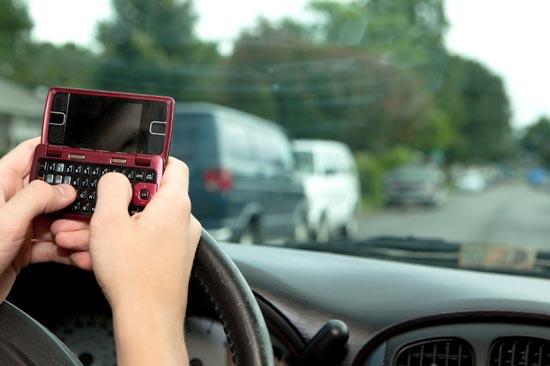
Currently, different states have different laws regarding cell phone use while behind the wheel of a car. Today the National Transportation Safety Board made a recommendation that that change, though, as the five-member group has called for a nationwide ban on the use of personal electronic devices while using a vehicle except in emergency situations. The recommended ban would cover all devices other than ones intended to aid in the driving task. In its proposal, the NTSB points to a 2010 accident caused by a pickup truck driver that had sent and received 11 text messages in 11 minutes leading up to the wreck, which ultimately killed two people and injured 38 others.
As I mentioned before, many states already have laws in place about using phones while operating a vehicle. However, most of them vary depending on things like the age/experience of the driver and the way the device is being used (handheld or hands-free), and it's likely they're not always completely enforced. It's tough to say whether the NTSB's recommended total ban would change things in states that adopt it as a law, but it'd be interesting to see if it would have an effect on enforcement of the law and the amount of distracted driving accidents. What do you all make of the NTSB's recommendation? Should states adopt a ban on all use of electronic devices while driving a car?
No call, no text, no update behind the wheel: NTSB calls for nationwide ban on PEDs while driving
December 13, 2011
Following today's Board meeting on the 2010 multi-vehicle highway accident in Gray Summit, Missouri, the National Transportation Safety Board (NTSB) called for the first-ever nationwide ban on driver use of personal electronic devices (PEDs) while operating a motor vehicle.
The safety recommendation specifically calls for the 50 states and the District of Columbia to ban the nonemergency use of portable electronic devices (other than those designed to support the driving task) for all drivers. The safety recommendation also urges use of the NHTSA model of high-visibility enforcement to support these bans and implementation of targeted communication campaigns to inform motorists of the new law and heightened enforcement.
"According to NHTSA, more than 3,000 people lost their lives last year in distraction-related accidents", said Chairman Deborah A.P. Hersman. "It is time for all of us to stand up for safety by turning off electronic devices when driving."
"No call, no text, no update, is worth a human life."
On August 5, 2010, on a section of Interstate 44 in Gray Summit, Missouri, a pickup truck ran into the back of a truck-tractor that had slowed due to an active construction zone. The pickup truck, in turn, was struck from behind by a school bus. That school bus was then hit by a second school bus that had been following. As a result, two people died and 38 others were injured.
The NTSB's investigation revealed that the pickup driver sent and received 11 text messages in the 11 minutes preceding the accident. The last text was received moments before the pickup struck the truck-tractor.
The Missouri accident is the most recent distraction accident the NTSB has investigated. However, the first investigation involving distraction from a wireless electronic device occurred in 2002, when a novice driver, distracted by a conversation on her cell phone, veered off the roadway in Largo, Maryland, crossed the median, flipped the car over, and killed five people.
Since then, the NTSB has seen the deadliness of distraction across all modes of transportation.
In 2004, an experienced motorcoach driver, distracted on his hands-free cell phone, failed to move to the center lane and struck the underside of an arched stone bridge on the George Washington Parkway in Alexandria, Virginia. Eleven of the 27 high school students were injured;
In the 2008 collision of a commuter train with a freight train in Chatsworth, California, the commuter train engineer, who had a history of using his cell phone for personal communications while on duty, ran a red signal while texting. That train collided head on with a freight train - killing 25 and injuring dozens;
In 2009, two airline pilots were out of radio communication with air traffic control for more than an hour because they were distracted by their personal laptops. They overflew their destination by more than 100 miles, only realizing their error when a flight attendant inquired about preparing for arrival.
In Philadelphia in 2010, a barge being towed by a tugboat ran over an amphibious "duck" boat in the Delaware River, killing two Hungarian tourists. The tugboat mate failed to maintain a proper lookout due to repeated use of a cell-phone and laptop computer;
In 2010, near Munfordville, Kentucky, a truck-tractor in combination with a 53-foot-long trailer, left its lane, crossed the median and collided with a 15-passenger van. The truck driver failed to maintain control of his vehicle because he was distracted by use of his cell-phone. The accident resulted in 11 fatalities
In the last two decades, there has been exponential growth in the use of cell-phone and personal electronic devices. Globally, there are 5.3 billion mobile phone subscribers or 77 percent of the world population. In the United States, that percentage is even higher - it exceeds 100 percent.
Further, a Virginia Tech Transportation Institute study of commercial drivers found that a safety-critical event is 163 times more likely if a driver is texting, e-mailing, or accessing the Internet.
"The data is clear; the time to act is now. How many more lives will be lost before we, as a society, change our attitudes about the deadliness of distractions?" Hersman said.
A synopsis of the NTSB report, including the probable cause, findings, and a complete list of the safety recommendations, will be available online after the meeting.
The NTSB's full report will be available on the website in several weeks.
Via Android Central